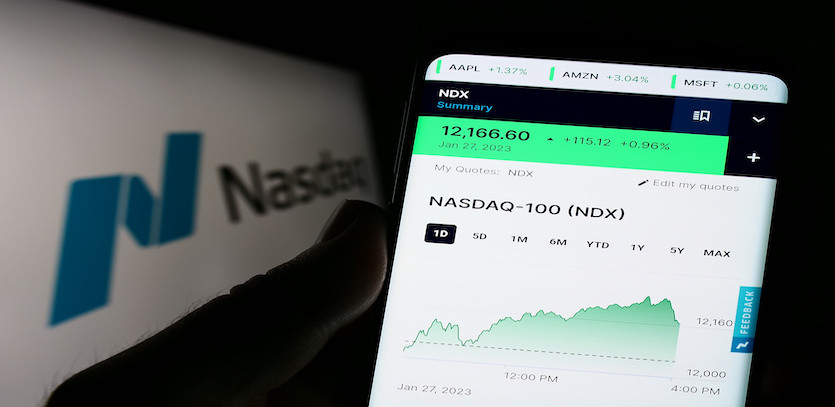Decoding the Nasdaq 100 Index
When you hear phrases such as "the Dow is slipping" or "the Nasdaq just edged higher," do you comprehend the significance? These statements point to major stock market indices which give a snapshot of the performance of various stocks. The Nasdaq 100 index, a well-recognized one, monitors the performance of 100 of the most influential and innovative non-financial entities listed on the Nasdaq stock exchange. The Nasdaq 100 is a crucial barometer for the overall health of Nasdaq-listed stocks, offering insights into the broader market trends.
A Closer Look at the Nasdaq 100 Index
Ranked second in the world, the Nasdaq stock exchange sits just behind the New York Stock Exchange (NYSE) in size. Nasdaq boasts more than 4,000 listed companies, cumulating a staggering market value of over $12 trillion. In comparison to NYSE-listed entities, Nasdaq-listed companies are more focused on technology and innovation.
The Nasdaq 100 is an index that showcases the performance of 100 of the largest, most traded stocks on the Nasdaq. This index represents a diverse collection of both domestic and international corporations from sectors like:
- Basic materials
- Consumer goods and services
- Healthcare
- Industrial
- Technology
- Telecommunications
- Utilities
Identifying Companies within the Nasdaq 100
The Nasdaq 100 comprises several popular entities, such as global giants Apple (AAPL) and Starbucks (SBUX). Companies find their place in the Nasdaq 100 through a modified market capitalization-weighted index, generally represented by large-cap stocks.
Prominent companies within the Nasdaq 100 include:
- Biogen (BIIB)
- Exelon Corporation (EXC)
- Honeywell International (HON)
- Intel (INTC)
- Intuit (INTU)
- Moderna (MRNA)
- Netflix (NFLX)
- PepsiCo (PEP)
- Ross Stores (ROST)
- The Kraft Heinz Company (KHC)
- XCel Energy (XEL)
The Nasdaq website hosts the complete list of companies within the Nasdaq 100. The index weighting calculation involves a sophisticated methodology. Though the index accommodates companies across various industries, technology companies dominate with about 56% of the index’s weightage.
The index undergoes quarterly rebalancing in March, June, September, and December. It also sees shifts in its constituent companies, with new stocks replacing others. Any such restructuring announcements occur in early December.
Nasdaq 100 versus Other Indices
The Nasdaq 100 forms just one piece of the puzzle in the array of indices tracking stock market performance. Two other prominent markers are the S&P 500 and the Dow Jones Industrial Average (DJIA).
Nasdaq 100 vs. S&P 500: Unlike the narrower Nasdaq 100, the S&P 500 encompasses 500 of the largest companies from a broad spectrum of sectors. It solely tracks U.S.-based companies, and it is also market capitalization-weighted, with each company’s index share reflecting its total market value of outstanding shares. There's a degree of overlap between the Nasdaq 100 and the S&P 500, but the latter has a more balanced sector distribution and is not as heavily concentrated on technology. Only 26% of the S&P 500 comprises technology stocks. Other significant categories include healthcare, finance, and consumer discretionary spending.
Nasdaq 100 vs. Dow Jones Industrial Average: The DJIA is one of the earliest indices and tracks just 30 companies, consisting of large U.S. companies only. These are typically blue-chip stocks, stable and established entities with consistent returns. Even though the DJIA tracks fewer stocks, it is still seen as a key indicator of the market's health due to its comprehensive coverage of major sectors. Companies within the DJIA include:
- Coca-Cola (KO)
- Goldman Sachs Group (GS)
- UnitedHealth Group (UNH)
- Verizon Communications (VZ)
- Walmart (WMT)
- Walt Disney (DIS)
The Performance of the Nasdaq 100
In the past half-decade, the Nasdaq 100 has surged by 92%, outperforming the S&P 500 (which rose by 52%) and the DJIA (which climbed by 37%). Despite experiencing sharper fluctuations, the Nasdaq 100 still surpassed these indices.
Investing in the Nasdaq 100
While one cannot directly invest in the Nasdaq 100, several strategies can emulate its performance.
Invest in Individual Stocks: You can choose to purchase shares of companies within the index, such as Apple, mirroring the index's portfolio. This strategy, though labor-intensive and potentially costly, requires thorough research and individual stock purchasing. You also need to follow the index's weighting to manage your portfolio.
Invest in Index Funds: A more straightforward option is investing in index funds, such as mutual funds and ETFs, tracking the Nasdaq 100's performance. These funds either include all companies within the Nasdaq 100 or a representative sample. They offer the opportunity to invest in many companies with a single investment.
Index funds are ideal for passive investors aiming for long-term goals due to their lower fees. Three widely recognized Nasdaq 100 index funds include:
- Invesco QQQ ETF (QQQ): QQQ is the second most-traded ETF in the U.S., encompassing all companies within the Nasdaq 100 index.
- Invesco NASDAQ 100 Index Fund (IVNQX): This mutual fund reflects the results of the Nasdaq 100, incorporating all entities within the index.
- Victory Nasdaq-100 Index Fund (USNQX): The Victory Nasdaq-100 Index Fund has a minimum investment of $3,000 and invests at least 80% of its assets in Nasdaq 100 index companies.
Wrapping Up: Understanding the Nasdaq 100 Index
Grasping the concept of indices, particularly the Nasdaq 100, is integral for any investor seeking to navigate the financial markets effectively. By tracking the performance of the 100 most influential non-financial companies listed on the Nasdaq exchange, the Nasdaq 100 serves as a critical measure of market trends and the health of Nasdaq-listed stocks. Its comparison with other indices like the S&P 500 and DJIA further sheds light on the market's overall direction. Investors can leverage this understanding, choosing to invest either directly in the stocks comprising the index or more conveniently through index funds. Thus, with a keen comprehension of the Nasdaq 100, investors are better equipped to make informed investment decisions and optimize their portfolio's performance.





